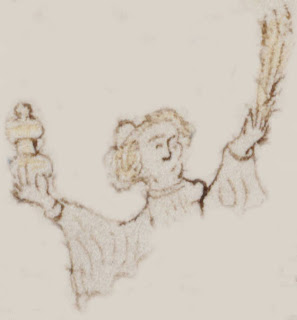If (like me) you enjoyed Roman Polanski’s film “The Ninth Gate” (I happened to see it in a hotel room in New Haven, giving it a particular resonance for me) which I mentioned recently, you might think about reading the novel from which it sprang, Arturo Perez-Reverte’s “The Dumas Club”.
Its main protagonist, Lucas Corso, gets described early on as a “book detective”: but he is closer to the romantic archetype of a charmingly ruthless European antiquarian book-hunter for which Wilfrid Voynich and Hans Kraus both felt nostalgic. Whenever short-sighted, boyish-looking Corso takes off his glasses and puts on his “innocent rabbit” face, everyone seems to give him what he wants: perhaps Wilfrid Voynich used much the same kind of trick, who knows?
But it’s not simply a cherchez-la-livre romance: there are two stories intertwined, one concerning various Spanish book-dealers’ passions for Alexander Dumas’ pulpy (but vastly popular) bestsellers such as “The Three Musketeers”; and the other about the three remaining copies of a mysterious 17th century printed book for summoning the Devil, written in heavily abbreviated/coded Latin and with nine Tarot-like drawings, and whose printer (Aristide Torchia) was supposedly burned at the stake for creating it.
Structurally, this reminds me a lot of the TV show “CSI” (the proper Las Vegas one), which typically fills its hour-long slot by telling two forensic detective stories (each roughly half-hour long), and leaving it as a point of suspense whether the two strands are connected or not. Lucas Corso struggles gamely to see the link, but ultimately none materialises in the way that he expects. Despite the reader’s (and Corso’s) sense of a buzzing conspiratorial coherency in the early few chapters, the book actually ends up more like two intertwined extended short stories (one horror, one literary) than a single majestic novel, which is a shame.
For the film adaptation, Polanski simply ditched the whole Dumas connection, and instead concentrated on the “Book of Nine Gates” half of the book – essentially, whereas he optioned “The Dumas Club”, he actually filmed “The Non-Dumas Club”.
Yet the first hundred pages are simply brilliant, inspiring, edgy, like peering anxiously through Montecristo cigar fug to make out the looming shape of an unknown menace. But then Perez-Reverte (quite literally) loses the plot: the writing disintegrates into a mess of intertextuality and clunky self-referentiality, with the novelist having Corso continually feel as if he is a character in a serial novel – essentially, in a remake of a Dumas novel. Whether that’s true or not, having it rammed down my, errrm, eyes so many times completely broke the spell.
One glaringly missed opportunity throughout is the aspect of whether the unidentified young girl (who takes the name “Irene Adler” from a Sherlock Holmes novel) actually exists, or is merely some kind of strange hallucinatory being, conjured up by Corso himself: a kind of “Dumas Club” meets “Fight Club”, if you like. Kudos to Polanski for picking up this angle more strongly in his film. Perhaps she had to physically exist in the book as a result of Perez-Reverte’s (I think wrong) decision to have to have one of the characters (Boris Balkan) as the storyteller. And so in the book, Irene’s ambiguity centres not on whether or not she exists outside Corso’ mind, but on whether for him she acts as a force for good or evil – an angel, succubus or demon.
All in all, I have to say that I really wish Perez-Reverte had found sufficient writing courage to take the horror through to its logical conclusion, rather than pull up short at the final hurdle. Though Polanski’s literary take on the novel was (perhaps necessarily) quite superficial, his filmic instinct to raise the stakes yet higher than the book worked fabulously well.
For the full literary effect, I’d recommend reading “The Three Musketeers” first, then “Twenty Years After”, then “The Dumas Club”, and then watching “The Ninth Gate” late at night, with the curtains drawn, and a bottle of Bols gin by your side. Enjoy!
Incidentally, looking at the book with my Voynich research hat on, it was nice to see Perez-Reverte pick up on things like “The art of locking devils inside bottles or books is very ancient… Gervase of Tilbury and Gerson both mentioned it in the thirteenth and fourteenth centuries” (p.202), and to have Torchia trawling around Prague for the cabalistic secrets of an unknown brotherhood (p.203). The uber-convoluted magic circle in the final chapter (p.312) is quite fun, too.
Of the three magic circles in the Voynich Manuscript, it is interesting that both sun and moon ones depict people holding bottles: here’s the left man from the “hidden moon” magic circle – the “S” in his face probably denotes “Septentrio” (i.e. North). I’ll write more about these another day: here’s a link to an earlier post I made on William Kiesel’s lecture at Treadwell’s. Suffice it to say that this picture might simply refer to water and hyssop, both used to purify magic circles for millennia… unless you know better?

